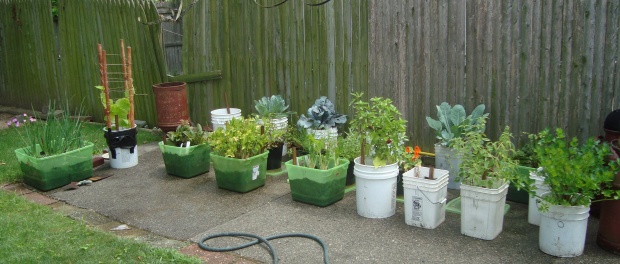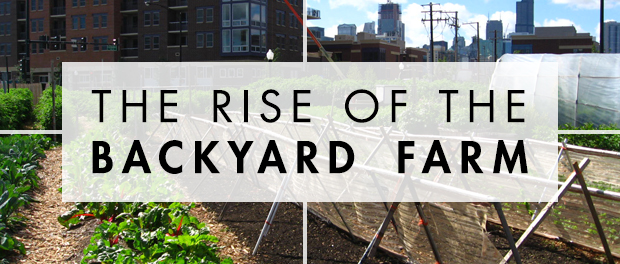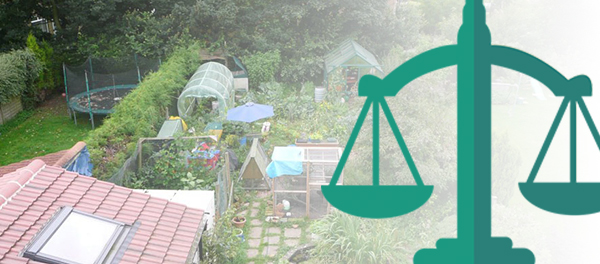Want a Backyard Farm in Ann Arbor or Saline Michigan ?
The Rise of the Backyard Farm
As a national speaker and edible landscaping expert, Rosalind Creasy has seen a sea change in how the public views growing food and tending to food-producing fauna in their yards. She says that, just as a segment of society has traded in the allure of the huge, gas-guzzling Cadillac for sleeker, more efficient cars, so too have we redefined the concept of a desirable outdoor space. “It used to be that having a big lawn and lots of shrubs was a status symbol, showing you have so much land and so many servants and so much money you didn’t have to use your land to just grow food,” Creasy says. “But now edibles have cachet. They are in. They’re sustainable. They’re healthy. Wealthy, educated people in particular are aware that this is the new status symbol.”
A Buzz in the Air
It’s not just gardens that are creating buzz. There’s no doubt in the mind of American Beekeeping Federation President Tim Tucker that the backyard beehive trend is going mainstream. “The number of beekeepers of one to five hives is growing by leaps and bounds,” he says. Part of this is fueled by the shock over the problem of colony collapse disorder, a mysterious event where entire colonies of bees perish. “People do want to help,” he says. However, Tucker says he also sees a growing interest from older Home owners, some of whom are having trouble finding wild bees for fruit trees and other plants that rely on pollination. “There’s also this movement of the baby boom generation toward more sustainable practices. They see it as a hobby that will help their garden.”
Chicago home owner Jean Bryan says she’s excited about the uptick in people interested in agriculture in her Rogers Park neighborhood. “This neighborhood is very chicken-heavy,” she says with a smile. “There’s a real tipping point in terms of our awareness of healthy food and the need for having food closer at hand.”
With the increasing interest in local food production, Bryan knows her yard—at 50 by 170 feet, it’s larger than the average Chicago lot—is enviable for city dwellers. She has room for a coop that offers protection and a “chicken run” that allows her seven hens outdoor space to scratch and forage. “There’s an increasing interest in home production of food—chickens are a subset of that—and the size of our yard would be very attractive to someone who was into that.”
The yard also offers a head start for gardeners that’s been decades in the making. “Besides the size of the yard, which would be a big selling point, we already have a raised-bed garden that was started by the original owners of the house,” Bryan says. “That part of the yard has been a garden for decades, and its soil has been built up significantly.”
Bryan says she and her husband are not looking to sell right now, but that having a real estate pro who understands the market for their home would be important. She says she thinks today’s chicken coop is yesterday’s solar panel. While a few years ago, agents might have recommended terminating a solar panel Lease at a home before putting it on the market, “I really think they’re becoming something of value.”
Josh Friberg, green, a realty sales associate in Portland, Ore., says it’s simple to change your thinking about the needs of this subset of buyers. “It takes a different kind of property for a Yorkie versus a Great Dane,” he says. “It really only takes a small shift in mindset to consider what’s going to be appropriate for chickens.”
Knowing the Rules
Governments are beginning to see benefits to localizing food production. More than a dozen states have recently enacted legislation promoting small-scale agriculture, and a smaller number, including Hawaii, Louisiana, North Carolina, and Oklahoma, have looked into or introduced incentives to encourage people to pursue backyard food production on residential property, according to the National Conference of State Legislatures.
Where municipalities and agencies do restrict or monitor agricultural activity on residential land, they are rarely out to squelch those practices with regulations, which are often created to protect home owners. Tucker says part of the reason it’s hard for his organization to get reliable numbers about the beekeeper population in the U.S. is because many residents with just a few hives try to avoid state monitoring programs. “Unfortunately it’s going to get more involved and there are going to be more requirements for beekeepers,” he says. However, he notes this will make for healthier bees, as agricultural agencies track disease and ensure that pesticide companies are aware of any no-spray zones in residential areas.
Other restrictions are based on so-called “nuisance laws,” which attempt to keep neighborhoods harmonious. Friberg says the complaint-based system in Portland is governed by this principle. He needed a permit for his backyard farm, which is home to goats, turkeys, chickens, honeybees, and a massive vegetable garden (the city allows residents to have up to three livestock animals without a permit). However, he says the permitting process is easy if you have a good relationship with your neighbors. Even visits from county disease control officials center on how comfortable nearby people are with his activities. “They mostly want to know what your relationships are with neighbors,” he says. “Also, I make homemade beer and a lot of that does go over the fence. All of a sudden you’ve got really happy neighbors!”
You might counsel buyers interested in residential food production to reach out to potential neighbors before committing to a new home. “It’s always a good idea to know your neighbors,” Tucker says. He adds that because bees need access to water, even a nearby bird bath can draw their attention. If a potential neighbor has both an outdoor swimming pool and a severe bee allergy, it might not be the best fit. (Another tip from Tucker for mobile beekeepers: Don’t pick a place that’s too close to the previous hive. “If you only move [the bees] a quarter of a mile, they’re going to go back to their old site.”)
But in the early stages of helping buyers, it’s important to know the local laws. When Sarah Snodgrass, a agent in Kansas City, Mo., was looking into the possibility of starting a coop in her backyard, she found the overlapping regulations incredibly confusing. “Before I got chickens I thought, ‘Well, am I allowed? What’s the deal?'” she remembers. A home may be in a city where a coop is acceptable but “you might be in a subdivision that doesn’t allow chickens.”
Cities might mandate minimum space requirements around coops or restrict the number of chickens home owners may legally have, and some prohibit rooster ownership altogether. Additional restrictions may exist on a smaller scale, through home owner associations. To make the situation clearer, Snodgrass put together a chart on her blog, which she updates as changes occur. Not only does she reference it often in her own business, she says clients and real estate pros often come to her for advice on urban farming. “They think I will understand them and be able to help them better than anyone else,” Snodgrass says.

Marketing Your Expertise
Snodgrass is currently working with buyers looking to start up a backyard chicken coop. But it’s not just her blog that helps her connect with this community. She’s currently working toward becoming a master gardener, taking classes through the University of Missouri’s extension program and volunteering in the community. She says agents who want to follow her lead should gather expertise in what they’re passionate about. “Be yourself. You have so many ways to connect—from local activities to online outreach via social media. Get out there, be professional, but, most important, be authentic,” Snodgrass says. “Buyers and sellers want to work with a real estate pro who will understand them.”
Friberg says his agricultural expertise has led to several referrals. He holds his annual client appreciation event at a pumpkin patch, mentions how the livestock are doing in his newsletter, and can be seen taking his goats for leashed walks around the community. “This is who I am, and people know that,” Friberg says. “I just got an e-mail from a former neighbor who said, ‘I really want to have the lifestyle that you and your wife have, and I think you could help me with that.'”
So what happens when a seller with a coop, beehive, or massive garden is ready to sell? Bryan suggests agents ask chicken coop owners whether they plan to take the coop with them. Creasy says conversations with sellers can also inform your marketing plan: “Ask them what are the things in their yard that make them happy,” she says. “If they say, ‘I’ve grown $700 worth of food out of this box,’ don’t you think that’s worth mentioning to buyers?”
Creasy also recommends using the fruits of edible landscaping in staging, perhaps gathering a few sun-ripened tomatoes from the garden and arranging them in a rustic basket. She’s helped several clients get their yards ready to sell and says anything from a mini-orchard to a tidy herb garden off the kitchen can help. “Plants like thyme are so easy; they don’t ask for anything,” Creasy says. “I call them edible plants with training wheels.” But you may need several months’ lead time to make sure all the plantings are ready. “It’s different with landscaping,” she says. “You can’t walk in and set up a few decorative pillows and take down the pictures.”
Friberg suggests ensuring farming structures are in good shape. He remembers working with one seller whose chicken coop was in disrepair. “We had to spend time mucking out the coop to really make it look nice. We were also prepared to remove it [if buyers insisted],” he says. “The goal was making it look as pleasing as possible.” Friberg helps widen the appeal of chicken runs by suggesting alternative uses in his listing notes, such as repurposing them for dogs or gardening. “It’s all about recognizing that there are multiple functions for these items,” he says. “I make sure this is part of the conversation.”
Creasy says the industry will benefit from understanding the growing mini-farm movement: “Real estate agents should get to know more about food, because the public is integrating food into their whole lifestyle.” And we’ve all got to eat.
If you are looking for a property with a bit more lot space for you to plant your own backyard garden, call, text or email. I can help!
Tom Stachler, Real Estate One, Ann Arbor, Michigan, farming, backyard, goats, chickens, coop, crops, raising, bee's, hives, agriculture




